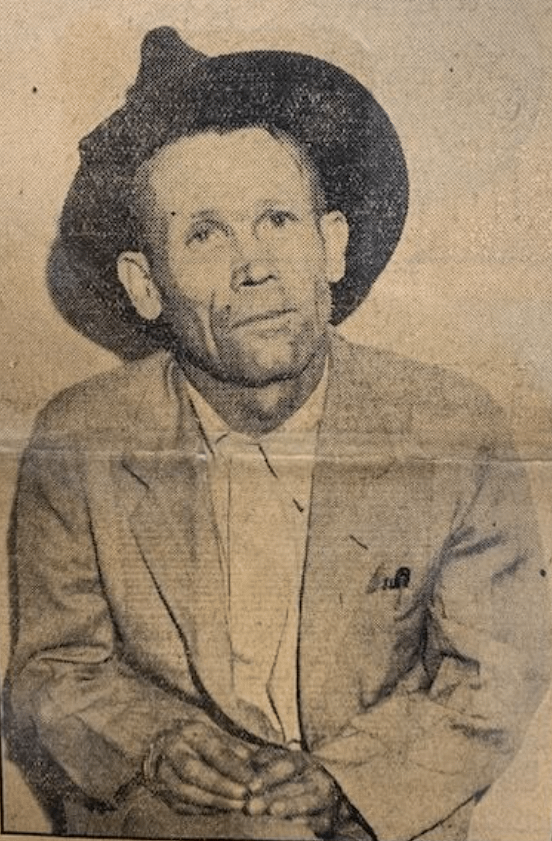
A jailhouse photo of D.B. Napier, taken after his arrest for raping and murdering a teenage girl. After the police saved him from a lynch mob, a shaken Napier confessed that he’d once helped lynch someone nearly 20 years earlier. The confession made national headlines, Louisiana, 1934 [552 x 841].
by lightiggy

3 Comments
[The story of D.B. Napier](https://imgur.com/a/story-of-d-b-napier-5RS37d7)
[A TIME article on the confession](https://time.com/archive/6863726/crime-according-to-st-matthew/)
Like his lynching victim, D.B. Napier, also known as Fred Lockhart, died at the end of a rope:
>”They were going to lynch him. It took every law officer in Shreveport to hold them off.”
Unlike his lynching victim, it was at the hands of the state, not the mob:
>Lockhart made his confession at 6 p. m., Tuesday. By 9:30 a crowd of 5,000 had surrounded the massive courthouse. About 500 formed into a group bent upon lynching the murderer. Hughes urged the crowd to go home while Bazer broadcast an appeal over the radio. This had the reverse effect of bringing hundreds more to the scene. The fire department was called into action, but the mob cut the hose and turned off the water. They smashed the courthouse doors.
>
>When tear gas repulsed them, others took their place. Again and again the mob charged, only to be thrown back. But the tear gas supply was running low. While more bombs were being rushed from nearby Barksdale flying field, the crowd broke into the building took possession of the first and second floors. Lockhart was taken from his seventh floor cell and hidden on the eighth floor.
>
>The elevators were taken to the top of the building while machine guns were set up the advance to higher stories of the courthouse. As the mob fell back momentarily, when the last of the tear gas supply was hurled against their ranks, two young girls mounted a truck and tried to urge the lynchers on. “You’re yellow if you don’t go in and get him,” they challenged. The mob rushed with renewed vigor. The situation was growing desperate.
>
>Then came reports that a crowd of 400 men were coming from south Arkansas to join the mob. The courthouse was being badly damaged and the mob’s fury was mounting. Sheriff Hughes called upon Governor O. K. Allen to send national guard troops to meet the crisis. The Shreveport company of the 156th infantry was called into action immediately, followed closely by companies from Minden, Ruston and Monroe.
Faced with relentless brute force, the mob backed down, allowing Napier to talk about his past:
>The four units, armed with machine guns, bayonets and tear gas bombs, soon quelled the mob and the situation grew quiet shortly after midnight.
[The mob would never get another chance](https://imgur.com/a/b3mbDU7):
>”Well, I know now how [Leo Frank](https://en.wikipedia.org/wiki/Leo_Frank) felt,” Lockhart declared to Sheriff Hughes after the mob had been dispersed. Lockhart then admitted that his real name was D. B. Napier, and that, under the alias of Fred Lockhart, he had escaped from a Georgia prison camp on August 19, 1931, while serving a life sentence for criminally assaulting a young girl in Crisp county.
>
>It was Lockhart who had been at the wheel of the lynchers’ car that carried Frank to his death.
[Not that it mattered anyway](https://imgur.com/a/FKBbMi2), as Napier was a hypocrite:
>”I know I am going to die and I want to tell it all,” he said. “You don’t need to bring anybody else up here.” He referred to a score or more persons who had interviewed him during the day and torn his alibi to shreds.
Unlike Leo Frank, Napier went to his death willingly:
>Mrs. Peters, returned from the burial of her daughter, visited the confessed slayer’s cell. “What do you think would be justice for you?” she asked. He wept and shook his head.
Napier would be hung on May 18, 1934, only a month after he had murdered Maggie Mae Giffin. He would be the last person executed by hanging in Shreveport.
Wow. Grade-A piece of shit.